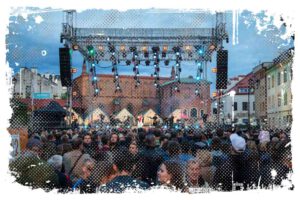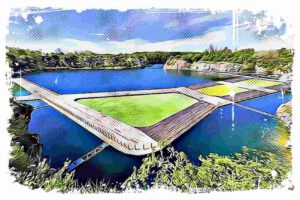I guess you are curious what Free City of Kraków was. Well, let me explain. Once upon a time, after the great Congress of Vienna, a bold decision was made. It was about the Duchy of Warsaw’s lands. You see, there were three big kids on the block – Austria, Prussia, and Russia – and they decided to divide the lands among themselves.

The tricky part was deciding who gets Krakow. The decision was made in a treaty on May 3, 1815, and I can tell you, it led to something entirely new. The Free City of Krakow came into being, carved out from Krakow and its immediate vicinity. We’re talking about a region of about 1,150 km.
The Big Three’s Influence Over the Free City of Kraków
Now, even though it was called the Free City of Krakow, it wasn’t exactly free. The three big countries – Russia, Austria, and Prussia – still had a hold over it. Let me say, its independence was, well, limited.
These powers had their representatives, known as residents, right there in Krakow.
What about the city’s political principles? Those were set up in advance by the three partitioning powers in the treaty of May 3, 1815. The complete text of the constitution was crafted later, officially announced in 1818.
↳ Make sure to read my guide to the most amazing places to stay in Kraków:
How to Find Best Place to Stay in Krakow Old Town – Your Guide
Republic’s Constitution
I am convinced you’re curious about what this constitution said. Well, it outlined a liberal and republican system. However, it wasn’t truly democratic. You see, they put in some restrictions, like for the higher offices.
You needed a certain level of property and education to get these jobs. This meant the big shots – nobility and aristocracy – had the main access to power. But they weren’t alone. The learned folk, professors, and academics from the Jagiellonian University also got a piece of the pie. And let’s not forget the bourgeoisie, always ready to challenge these groups.
The Powerplay Behind the Senate

The constitution also handed over executive power to a group called the Senate. Think of it as a club with 12 senators and a president. The president was supposed to be chosen by the Assembly of Representatives. But in reality, it was a different ballgame.
The big three – Russia, Austria, and Prussia – tried to have a say in who got the top job. This became clear around 1828 when these powers started nominating their own candidates. Usually, folks from the landed gentry, like Kasper Wielogłowski and Stanisław Wodzicki, got the honor.
The Senate had the power to fill and dismiss offices. They could even suggest new laws. Every resolution needed their approval before the Sejm (Assembly of Representatives) could vote on it. Over time, the Senate’s powers increased. But with this, the residents of the partitioning powers also strengthened their control over the Senate.
The Assembly of Representatives in Kraków Free City
Let’s talk about the legislative power, the ones who made the laws. It lay with a group called the Assembly of Representatives, with 41 seats in total. The majority of these seats were filled by communal assemblies. But there were also six justices of the peace, three senators chosen by the Senate, and a few others – three prelates and university professors.
Everyone in the Senate, except the deputies of communal asemblies, were known as virillists. The assembly got together once a year. Any decision they made had to follow the constitution, and they needed more than just a simple majority to pass a resolution.
Two Distinct Eras of the Free City
The history of the Free City of Krakow, or the Republic of Krakow as it’s also known, can be split into two periods.
The first era stretched from when the Republic was founded to the start of the November Uprising. This was when Krakow was somewhat independent and the influence of the big three partitioning powers wasn’t really felt. During the November Uprising, the folks of the Free City supported the insurgents and later welcomed refugees from the Kingdom of Poland. Signs of shrinking independence began showing up at the end of the 1820s. In 1827, for instance, Józef Nikorowicz’s election as the Senate president was canceled, and Count Stanisław Wodzicki was put back in the seat.
The Impact of the November Uprising
The Free City’s support for the November Uprising didn’t go unnoticed. The partitioning powers changed their tune about Krakow. The political freedoms started shrinking, and the role of the residents, part of the Conference of Residents, started growing.
In 1833, they got a new constitution which put a damper on their independence. It changed the structure of the authorities, reducing the Senate and Assembly’s size. They also decided that the Assembly would only meet every three years. Fast forward to 1836, the armies of the partitioning powers marched into Krakow. The city was under occupation until 1841, when the Prussian, Rusian, and Austrian troops left.
Economic Freedom in the Republic of Krakow
Despite all the political turmoil, the Republic of Krakow enjoyed a lot of economic freedom. There were loads of economic liberties that boosted trade (for instance, no import duty). The population of the Free City was also on the rise, partly due to folks coming in from Galicia and the Kingdom of Poland.
The peasants had it pretty good. They had personal freedom (a right they’ve had since the Duchy of Warsaw days). They had to pay benefits either as a natural pension or a compensatory pension. A special Peasant Commission was set up to keep things running smoothly for them. The Commission worked towards abolishing serfdom and renting of peasants. It was a success in church and state estates, and landowners followed suit, making changes in their own properties. So you see, even though there were political struggles, the Free City managed to find ways to thrive.
The Birth of the Free City of Kraków
The Free, Independent and Strictly Neutral City of Krakow with its District, commonly known as the Free City of Krakow or the Republic of Krakow, was created according to the rules set out by the Congress of Vienna.
As I already explained, this was established in an additional treaty signed by Austria, Prussia, and Russia on May 3, 1815, which was later attached to the final treaty on June 9, 1815. The Republic was officially announced on October 18, 1815, and the anniversary of this date was a public holiday.
The decision to create this little country came about due to a disagreement about the nationality of Krakow, which was a city important for both political and economic reasons. The talks reached a stalemate, and the solution was a Russian proposal to make Krakow and its surrounding area a neutral zone.
The Geography and Governance of the Free City
Covering an area of 1150 km², the Free City was home to 87,986 people in 1815. Other than Krakow, three more cities fell within its borders: Chrzanów, Trzebinia, and Nowa Góra, along with 224 villages.

The Commonwealth received a detailed constitution that outlined all the principles for its existence. It was to be ruled by the Governing Senate (acting as the government) and the House of Representatives (acting as the parliament). Stanisław Wodzicki, the prefect of the Krakow department during the Duchy of Warsaw era, led the Senate. The Senate consisted of landowners, officials, professors of the Jagiellonian University, and members of the Cathedral Chapter.
However, the state couldn’t conduct its own foreign policy. It was overseen by the protective powers – Russia, Austria, and Prussia. They each had permanent representatives, or residents, in Krakow. Three years later, the Constitution was significantly expanded, but the original principles remained unchanged.
The End of the Free City of Krakow
The Free City of Krakow lasted until 1846. After the Krakow Uprising, with the agreement of all three partitioning powers, its territory was annexed by Austria. Throughout its existence, it was the only autonomous area in the former Polish lands, alongside the Kingdom of Poland. This played a major role in shaping the history of Poles in the first half of the 19th century.
References:
- https://ank.gov.pl/wystawy/wolne-miasto-krakow-1815-1846-materialy-z-zasobu-krakowskiego-archiwum/
- https://pl.wikipedia.org/wiki/Wolne_Miasto_Krak%C3%B3w




